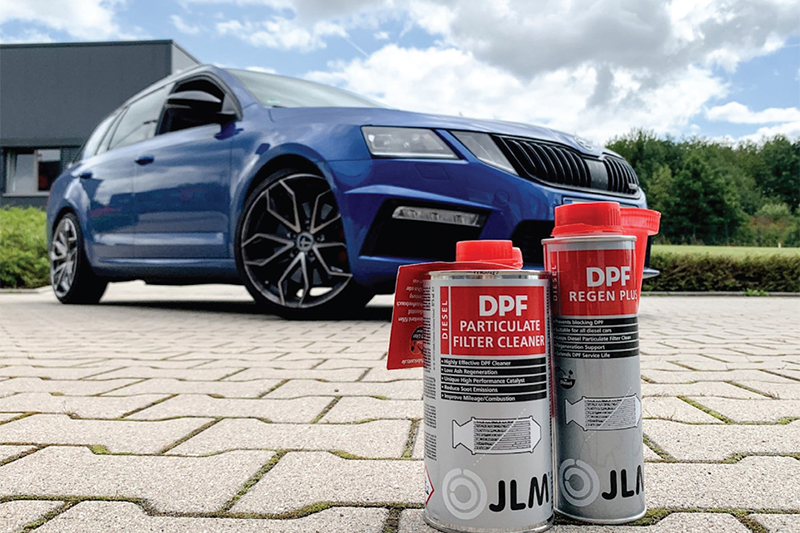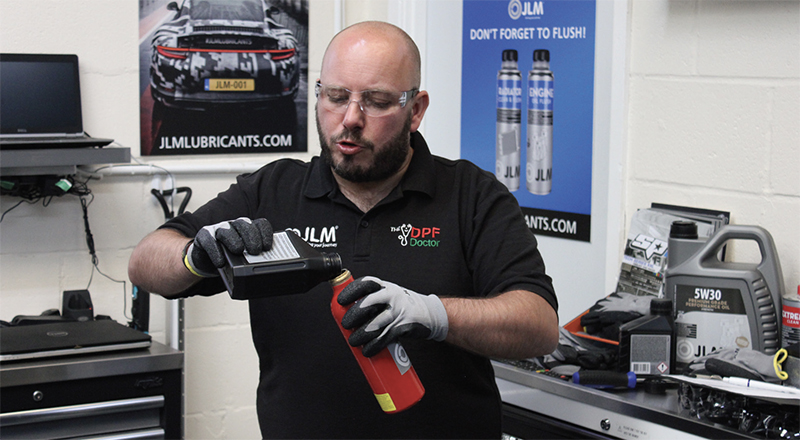
Customers think they can cure their vehicle’s ills with a bottle of bright stuff from the supermarket, well JLM and the DPF Doctor, Darren Darling both have one message: think again!
Despite the need for cars to remain in good condition, ignoring the warning lights and cutting back on servicing are worrying trends. The consequences are well documented with cars fitted with a DPF.
Motorists heading to their nearest retailer to add a bottle of cheap stuff (or fire juice, as Darren refers to it) when the DPF warning light comes on and, using cheap-as-chips DPF refill fluids could find themselves having to fork out for a new DPF.
Garages also have a crucial part to play with the additives they recommend to customers because as Darren says: “Out of every 10 DPF assessments I undertake usually six to seven are damaged beyond repair. The main issue is a lack of understanding from the customer but also from other garages. There’s widespread use of fire juice additives, incorrect cleaning techniques and mechanics simply hitting the forced regen button on the scan tool, hoping for the best.”
Recommending additives
So, when it comes to using and recommending DPF additives, where does the professional motor mechanic stand? Recent research from Castrol indicated the importance of technicians in steering the discussion towards using high quality products. Interestingly, this research revealed that motorists are happy to pay more for the additives mechanics use because they trust their expertise, highlighting the importance of choosing your additives based on credentials.

“Periodically the DPF will enter a regeneration ‘cleaning’ phase where the temperature in the filter is artificially elevated to burn off the particles thereby reducing the filter’s ‘soot’ load,” says Mike Schlup from Kalimex. “For this to happen the vehicle must be driven for a minimum distance, at high revs on the motorway or dual carriageway. The regeneration cycle must complete.
The reality? Many diesel vehicles are driven in environments where these higher temperatures are never achieved. The particle load in the DPF continues to rise without ever being burnt off. This can result in complete blockage of the filter requiring a professional clean. This is where DPF cleaning additives can help by introducing a catalyst into the filter that helps burn off the particles, even if the vehicle is not driven optimally.
“However, not all DPF additives are the same. There are significant differences depending on the type of catalyst used as the base ingredient” he continues.
“Ferrocene, or iron, is a commonly used catalyst which assists particle burn by artificially increasing the temperature in the DPF. Although achieving the overall aim of reducing the particulate load in the filter the downside is that the elevated temperatures of over 800 degrees Celsius risk irreversible damage to the DPF core, particularly with additive overuse. Iron-based catalysts also result in increased levels of ash deposits which can only be removed with an off vehicle physical clean of the DPF.”
“The alternative to iron is to use products with cerium and platinum. These precious metals help carbon deposits in the DPF burn off at a lower temperature, around 400 degrees Celsius. This not only helps protect and extend the life of the DPF core, but it also produces less ash, again extending DPF life. The DPF cleaning additives produced by JLM Lubricants are based on platinum and cerium. They cost a little more than iron-based additives, but the long-term benefits are huge, especially considering the cost of a new DPF.”

Cheap-as-chips
“We’ve seen an increase in problems caused by inferior quality DPF fluids due to little or no active ingredients,” says Darren Darling.
“By data logging cars during regeneration, we’ve noticed abnormal behaviour. DPF additive fluid is a fuel borne catalyst used on numerous vehicles including Peugeot, Citroen, Toyota, VW, Ford, and Volvo to lower the burn temperature of soot in the exhaust. In turn this reduces the timescale necessary for successful DPF regeneration.”
He continues “Without the correct amount of active ingredients (FBC) in the DPF fluid, the DPF system cannot function correctly, leading to premature blocking of the DPF, increased MPG and in some cases a damaged DPF. As DPF specialists we only use products that either meet or exceed OE spec. JLM Lubricants’ DPF refill fluid is the only product in our workshop.”
According to Gilbert Groot, JLM founder and CEO, “The market is flooded with cheap (DPF refill fluid) products which upon stringent, independent third-party testing demonstrate that the active ingredients are in such a small quantity they do nothing to aid the regeneration of the DPF. In fact, long term use of these products can cause the DPF to become damaged beyond repair. They lull the mechanic and the motorist into believing they’ve done the right thing topping up with them. Our DPF refill fluid contains the highest percentage possible of active ingredients.”
A final word
We end with this comment from leading #CarTechJourno Rob Marshall: “Cutting corners with a sub-standard top up fluid is virtually as bad as disabling the entire emissions’ control system. The DPF Management system will try to compensate with more frequent active regenerations, but this will harm not just fuel economy but also the DPF. The resultant increase in lubricant contamination could even cause permanent turbocharger and engine damage. With DPF refills, it’s either right, or wrong, with no middle ground.”









